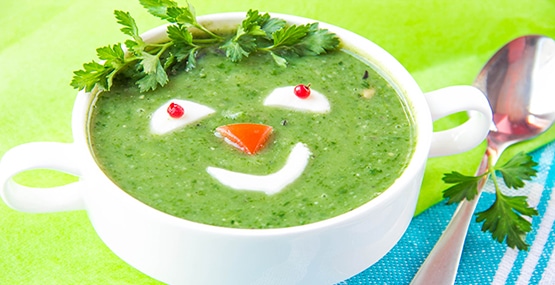
What Are Phytonutrients—and Why Should Parents Care?
These colorful compounds can help fortify your child’s immune system and boost brain health.
-Eat the rainbow. You've heard it from doctors, nutritionists, and cookbook authors for decades. And it makes sense: Fruits and vegetables are packed with vitamins, minerals, and good-for-you fiber.
But why is the rainbow, as an eating strategy, so golden? One word: phytonutrients.
Phytonutrients are a variety of naturally occurring compounds produced by plants that protect them from bugs, fungi, and natural elements like wind, sun, and rain, says Belinda Jenks, Ph.D., RDN, nutrition science and research consultant for Kate Farms. When you eat these plants, the health benefits are passed to you.
You've surely heard of these good guys before: antioxidants, phytochemicals, flavonoids, and polyphenols to name a few.
While phytonutrients are important for everyone, they're particularly crucial for children.

"Phytonutrients are important for improving immune systems and preventing infection," says Lucille Beseler, MS, RDN, president of the Family Nutrition Center of South Florida and past president of the Academy of Nutrition and Dietetics. "They also provide a strong, healthy diet that's important for a growing child's brain function, nerve function, and more."
Studies also suggest the first 1,000 days are most important for cognitive brain development and function, Beseler says, "so to overlook how important it is for children to get a well-balanced diet is doing a disservice."
With that in mind, here's what you need to know about phytonutrients—and how to make sure your children get what they need to stay protected.
Phytonutrient Fact #1: There Are Thousands of Varieties
Experts estimate there are up to 4,000 different phytonutrients in fruits, vegetables, grains, beans, nuts, tea, and spices. The most popular include:
- Carotenoids (mangoes, kale, tomatoes)
- Flavonoids (onions, tea, citrus fruit)
- Resveratrol (grapes, peanuts, cocoa)
- Ellagic acid (berries, pomegranate, pecans)
- Phytoestrogens (soy, flax, dried fruit)
- Glucosinolates (arugula, Brussels sprouts, radish)
That said, each phytonutrient comes from a variety of different plant sources, Jenks says, and they all have different potential health benefits you can score from regular consumption.
Phytonutrient Fact #2: They Have a Boatload of Benefits
There are six essential nutrients, according to the World Health Organization (WHO), which splits them into three groups.
First, there are macronutrients: carbohydrates, protein, and fat. Then there are micronutrients—your vitamins and minerals. Last is water, which is its own group because our bodies are up to 60 percent H20.
Phytonutrients aren't included in those groups, so they're not technically considered essential. But they do offer up a lot of health benefits, Beseler says.
For starters, phytonutrients can help reduce inflammation, and studies suggest increasing your intake of certain kinds, like the beta-carotene (carotenoid) found in carrots, sweet potato, and cantaloupe, may help neutralize free radicals that affect damaged cells, Beseler says.
"We know damaged cells can lead to cancer or other inflammatory diseases, like asthma or allergies," she says. "Beta-carotene is a phytonutrient that helps reduce that inflammation, lowering your risk."
They also help with upkeep of your immune system and general health, Jenks says. From bone health, lower cholesterol, and heart health to stronger lungs, eyes, and skin, getting a variety of phytonutrients into your diet can help create a well-rounded picture of health.
Phytonutrient Fact #3: You Should Aim for at Least 5 Servings a Day
There's no designated amount of phytonutrients that are recommended per day, but the famous "5 a Day" campaign from the Produce for Better Health Foundation became the accepted recommendation for the number of servings of fruits and vegetables the average person should aim for daily, Beseler says.
Just make sure those five servings include a wide variety of color, she adds—hence the "eat the rainbow" idea—as different colors provide different sources of phytonutrients (and their associated health benefits).
Phytonutrient Fact #4: They're Easy to Sneak into a Child's Diet
Again, you're going to nab phytonutrients primarily in vegetables, fruits, beans, and grains, Beseler says. But your child doesn't have to eat them straight-up if they're on the pickier side.
"Steam vegetables in a little chicken or vegetable broth, or roast them in the oven with olive oil and spices," Beseler suggests. "Make tacos and put shredded cabbage, carrots, and cucumber in—that's three different varieties and colors right there."
Making the moment an interactive one can also help. "Get the kids in there to help wash and cut your ingredients, and talk about how they grow," Beseler suggests. Doing so is likely to spark more conversation and engagement, in turn opening up their minds to the idea of trying and—gasp!—liking new things.
And, of course, Beseler says to practice what you preach, since sometimes parents forget their feeding patterns are modeled by their children the same way their actions are. So if you don't want them to eat potato chips out of a bag, it's better if they don't see you doing it, too. (As an alternative, you can always oven roast your own sweet potato chips for a serving of phytonutrients!)
Phytonutrient Fact #5: You Don't Need to Stress About Buying Organic
"Many families feel if they can't buy organic vegetables and fruit, they shouldn't buy anything because the conventional options are not healthy," Beseler says.
But it's not quite the right message. The most important thing is that you're buying and eating the produce—and remembering to wash it really well to remove any pesticides, she says. (Buying organic, however, is great if it's both accessible and you're focused on environmental sustainability.)
From there, consider buying food when it's in season in your region—think apples and pumpkins in the fall, stone fruits and bell peppers in summer, and strawberries and bitter greens like kale and spinach in the spring—to get the most nutrient-dense options on your plate. (Research also shows eating local produce is great for the environment.)
Buying frozen and canned goods is also an option if you have trouble with storage or access to fresh produce, as phytonutrients are fairly stable with different types of treatments, Jenks says.
That includes dried varieties too, adds Jenks, since phytonutrients withstand heat quite well. These fruits and vegetables are inexpensive, have a long shelf life, and come chock-full of flavor and phytonutrients that do your body—and your health—good.
This story has been medically reviewed by Stan Cohen, M.D., a pediatric gastroenterologist at the Children's Center for Digestive Health Care in Atlanta and the director of Nutrtion4Kids Medical Advisory Board.




